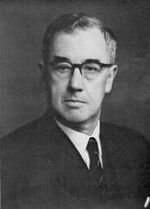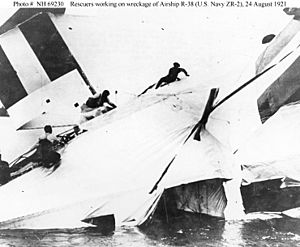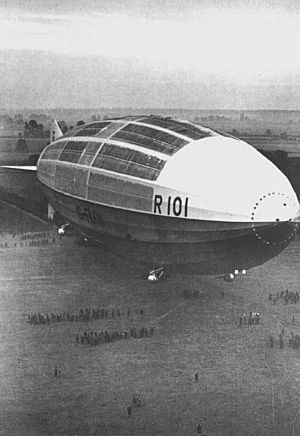Alfred Pippard facts for kids
Quick facts for kids
Alfred Pippard
|
|
|---|---|
 |
|
| Born | 6 April 1891 Yeovil, Somerset
|
| Died | 2 November 1969 (aged 78) Putney, London,
|
| Nationality | English |
| Education | University of Bristol |
| Occupation | Engineer |
| Engineering career | |
| Discipline | Civil, aeronautical |
| Institutions | Institution of Civil Engineers (president), Royal Society (fellow), |
| Projects | R100 and R101 airships |
Alfred John Sutton Pippard (6 April 1891 – 2 November 1969) was an important British engineer and teacher. He was born in Yeovil, England. His father was a carpenter, and Alfred often helped him on building sites.
Even though he was expected to join the family business, Alfred chose a different path. He decided to study civil engineering at the University of Bristol. He even won a special scholarship to help pay for his studies.
After university, he worked for an engineering company and a water board. When the First World War began, he joined the British Admiralty (the navy's department). There, he studied how strong aircraft needed to be.
After the war, he became a professor. He taught engineering at Cardiff University, Bristol University, and Imperial College, London. He was famous for his work on the design of the R100 and R101 airships.
During the Second World War, he helped with civil defense research. He also continued teaching. Later, he became the president of the Institution of Civil Engineers. He was also a Fellow of the Royal Society, a very high honor for scientists.
Contents
Becoming an Engineer
Alfred John Sutton Pippard was born in Yeovil on April 6, 1891. His father was a skilled carpenter and joiner. Alfred's family had many people who worked in construction. This included masons and plasterers.
Alfred often helped his father on building projects. His father was known for his craftsmanship. He worked on important buildings like the Yeovil Post Office.
Alfred went to school in Yeovil. Everyone thought he would join his father's business. But Alfred loved studying and wanted to learn more. He decided to apply to the Merchant Venturers College. This college later became part of the University of Bristol.
He worked for an architect for a year. He also studied for an important exam, which he passed in 1908. That autumn, he started his studies at the college.
During his first year at Bristol, Alfred's father passed away. This made things very hard for his family. They faced money problems. Luckily, Alfred won a special scholarship. This award paid for his tuition fees. It allowed him to keep studying. He graduated from Bristol in 1911 with top honors.
Starting His Career
To become a full member of the Institution of Civil Engineers, Alfred needed to work for an experienced engineer. He arranged to work for Mr. Cotterell in Bristol.
His family still needed money, so Alfred couldn't afford the usual apprenticeship fees. But he was lucky again! A new scholarship program had just started. Bristol University put Alfred's name forward, and he was chosen. This scholarship gave him the money he needed.
With this financial help, Alfred started working at Cotterell's office in 1911. One of his first tasks was to design the steel frame for a warehouse. He gave a talk about this project. For his excellent work, he won the Miller Prize. He received a set of drawing tools, which he used for the rest of his life.
He finished his training in 1913. Then, he got a job as an assistant engineer for a water board. He didn't enjoy this routine work very much. To keep his mind busy, he started writing a Master of Science paper. It was about masonry dams. He wrote it in the evenings and on weekends. He received his master's degree in 1914.
Working for the War Effort
A few months after World War I began, Alfred left his job at the water board. He wanted to help with the war. His eyesight was not good enough to join the army. So, he put his name on a list for engineers to help where needed.
In January 1915, Alfred got a job with the British Admiralty's Air Department. His job was to figure out how strong airframes needed to be. This was very important for making sure planes could survive air battles. He often worked long hours, sometimes ten to twelve hours a day.
In 1917, he married Olive Field. He was recognized for his war work in 1918. After the war, Alfred joined an engineering company. He and a colleague, JL Pritchard, wrote a book called Aeroplane Structures. This book became a key guide for aeronautical engineers. For this and other work, he earned a Doctorate of Science in 1920.
His company investigated airplane crashes. They looked into the failure of the Tarrant Tabor plane and the R38 airship disaster. But the company struggled to get big contracts. Alfred preferred teaching. He had started lecturing at Imperial College, London in 1919. In 1922, he became a professor of engineering at Cardiff University. He also wrote scripts for radio shows, including some for schools.
Life as a Professor
At Cardiff, Alfred worked to make the engineering department more modern. He also looked for new research projects. His most important client was the Aeronautical Research Committee. They paid for a full-time assistant to help him.
Alfred and his assistant, John Baker, worked on how to analyze the frames of airships. This was for the new R100 and R101 airships. In 1928, Alfred was invited to become the head of civil engineering at Bristol University. He accepted the offer.
At Bristol, he continued his work on the R100 and R101 airships. He even took part in the first test flight of the R101. However, there was pressure to finish the airship quickly. Alfred could not finish his full report on its structure before the R101 crashed on October 5, 1930. This crash ended Britain's work on airships.
The investigation into the crash found no problems with Alfred's work or the airship's structure. But Alfred was deeply affected by the event. Many of his friends were among the 48 people who died. After this, he stopped working on aeronautical engineering. He focused only on civil engineering.
In 1933, he moved to Imperial College, London. He took over the civil engineering department there. He encouraged students to focus more on research. He believed that university years should be about learning engineering science. He was very interested in the structure of dams. He also recognized the importance of soil mechanics early on. He even arranged for famous experts to give lectures on the topic.
Alfred also helped Letitia Chitty, a talented mathematician. He recruited her to work at the Admiralty Air Department during World War I. This experience made her switch to engineering. She later joined Alfred at Imperial College. They worked together on aircraft and airship structure projects.
During the Second World War
In April 1939, Alfred Pippard saw that war was coming. He joined the Civil Defence Research Committee. This committee was set up to prepare for air raid precautions.
When the Second World War started on September 3, 1939, he was assigned to a research section. This section did not have much work, and Alfred felt bored. It was very different from his busy work during the First World War.
Luckily, the government allowed university students to finish their degrees. This meant Alfred could spend four days a week teaching at Imperial College. He continued this throughout the war.
After the War
In 1944, Alfred was elected to the council of the Institution of Civil Engineers. He stayed on the council for fifteen years. He pushed for more academic people to be part of the institution. His dedication led to him becoming president for the 1958-59 term.
In 1946, he brought new lecturers to Imperial College. They taught about concrete and soil mechanics for the first time. In 1951, he was asked to investigate pollution in the Thames river. This was a very complex job. It took fifteen years of detailed study. Some newspapers criticized him for how long it took.
Alfred was elected a Fellow of the Royal Society in 1954. The next year, he became the assistant to the head of Imperial College. He retired in September 1956.
Retirement Years
After retiring, Alfred started giving lectures in the United States. He lectured at many universities, including Northwestern University, Berkeley, Purdue, and Harvard.
When he returned from America, he took on his duties as president of the Institution of Civil Engineers. This included a two-month visit to South Africa. In 1966, he received honorary degrees from Bristol University and Birmingham University. He also received one from Brunel University in 1968.
Alfred continued to write about the theory of structures. Throughout his life, he wrote or helped write over 80 academic papers and six books. He started writing his autobiography, but it was not finished when he died. Alfred Pippard passed away in Putney, London, on November 2, 1969.
Images for kids





